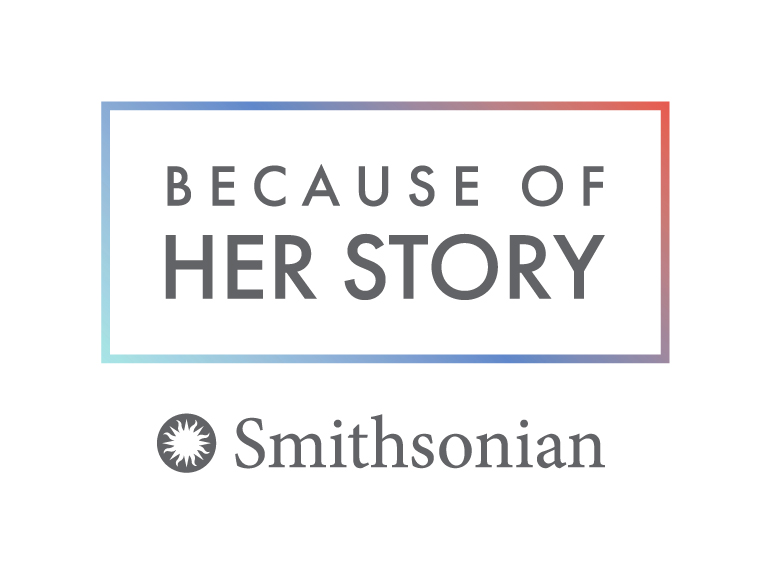Smithsonian Launches American Women’s History Initiative
“So I want all the girls watching here, now, to know that a new day is on the horizon! And when that new day finally dawns, it will be because of a lot of magnificent women…”
Oprah Winfrey, upon receiving the Cecil B. deMille Award at the Golden Globes, 2018
The Smithsonian has announced specific plans for the Smithsonian American Women’s History Initiative, Because of Her Story. The initiative strives to be the nation’s most comprehensive undertaking to document, research, collect, display and share the rich, complete and compelling story of women in America. It will greatly increase the Smithsonian’s research and programming related to women in the U.S., past and present.
Several exhibitions focusing on women’s contributions to American society will open next year as part of the initiative, with more to come in 2020 in recognition of the 100th anniversary of women’s suffrage in the United States. Funding from the federal government and private sources has allowed the Smithsonian to hire six additional curators devoted to women’s history and related areas.
“We all need to do a better job recognizing and celebrating the impact women have made throughout our nation’s history and their increasing importance in every facet of our national life, a fact underscored by the record numbers of women set to fill the halls of Congress,” said David Skorton, Secretary of the Smithsonian. “The Smithsonian American Women’s History Initiative will greatly amplify our ability to tell the stories of American women and remind everyone that our collective national progress has always depended on their monumental and often unsung contributions.”
“With this initiative, we will rewrite the narrative of American history by amplifying women’s voices, reaching diverse audiences and empowering future generations,” said Stephanie Stebich, co-chair of the American Women’s History Initiative. “This Smithsonian-wide effort will spotlight the remarkable achievements of American women.”
The initiative includes collections-care projects such as preserving the National Air and Space Museum’s Northrop T-38A flown by Jacqueline Cochran, and cataloging of 1,800 objects in the women’s political history collection at the National Museum of American History.
In October 2019, Smithsonian Books will release Smithsonian American Women: Women’s History from the National Collection [working title], featuring more than 280 artifacts from Smithsonian museums, archives, research centers and libraries.
The Smithsonian is committed to making the American Women’s History Initiative accessible to global audiences. To do so, it will partner with the Case Foundation for the initiative’s digital strategy. This collaboration will not only create new avenues for telling the stories of American women, but also enhance the achievement of the Smithsonian’s strategic goal to reach 1 billion people annually by 2020.
Exhibitions
Among the exhibitions slated for 2019 are:
“Votes for Women: A Portrait of Persistence”
March 1, 2019–Jan. 5, 2020; National Portrait Gallery
This major exhibition reveals the women and organizations that are often overlooked in the complex narrative of women’s suffrage in the United States. Through portraiture, biography and material culture, the exhibition examines the contributions of the radical women in antislavery societies, women activists of the late 19th century, the “New Woman” of the turn of the century and the militant suffragists of the 1910s. This presentation also highlights the struggles that minority women endured long after the passage of the 19th Amendment.
“All Work and No Pay: A History of Women’s Invisible Labor”
March 4, 2019–February 2020; National Museum of American History
Break rooms across America hold signs that read: “Your mother doesn’t work here.” The National Museum of American History’s exhibition “All Work and No Pay: A History of Women’s Invisible Labor” examines just that: the implied expectation that women will take care of the housework. The exhibition shows that despite making steps forward in the paid labor force, women continue to be responsible for the almost-timeless and undeniably endless unpaid work at home.
“Tiffany Chung: Vietnam, Past Is Prologue”
March 15, 2019–Aug. 25, 2019; Smithsonian American Art Museum
Internationally acclaimed artist Tiffany Chung (b. 1969, Da Nang, Vietnam) is known for her multimedia work that explores migration, conflict and shifting geographies in the wake of political and natural upheavals. Through this work, Chung documents accounts that have largely been left out of official histories of the period and begins to tell an alternative story of the war’s ideology and effects.
“Women of Progress: Early Camera Portraits”
June 14, 2019–May 31, 2020; National Portrait Gallery
In mid-19th-century America, the growing presence of women in public life coincided with the rise of portrait photography. This exhibition of daguerreotypes and ambrotypes from the 1840s and 1850s features portraits of early feminist icons, such as women’s rights advocates Margaret Fuller and Lucy Stone, abolitionist Lucretia Mott and best-selling author Harriet Beecher Stowe.
“Pat Steir”
Oct. 24, 2019–May 10, 2020; Hirshhorn Museum and Sculpture Garden
The Hirshhorn will host the largest site-specific exhibition to date by the acclaimed abstract painter Pat Steir. The exhibition is an expansive new suite of the artist’s signature “Waterfall” paintings, spanning the entire perimeter of the museum’s second-floor inner-circle galleries, extending nearly 400 linear feet. The 28 large-scale paintings, when presented together as a group, will create an immense color wheel that shifts hues with each painting, with the pours on each canvas often appearing in the complementary hue of the monochrome background.
The Smithsonian American Women’s History Initiative is chaired by Stephanie Stebich, The Margaret and Terry Stent Director of the Smithsonian American Art Museum, and John Davis, Smithsonian Provost. Initial support for the initiative came from congressional funding and these individuals and foundations: Mary and David Boies, the Case Foundation, the Dick and Betsy DeVos Family Foundation, the Ford Foundation, the Bill & Melinda Gates Foundation, and David M. Rubenstein.
# # #
SI-616-2018
Linda St. Thomas
202-841-2517
Alex Fairchild
(202) 633-0282
fairchilda@si.edu

